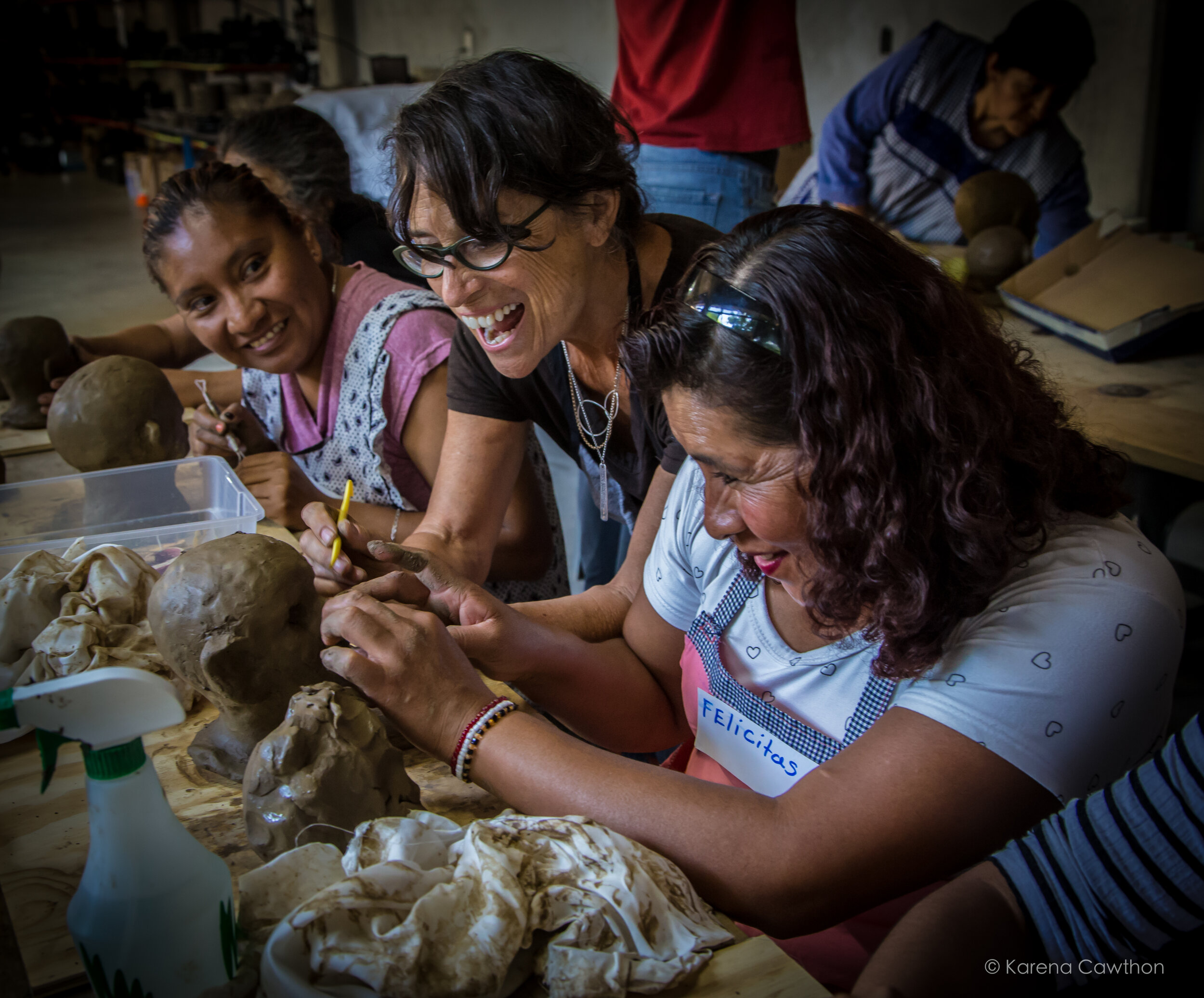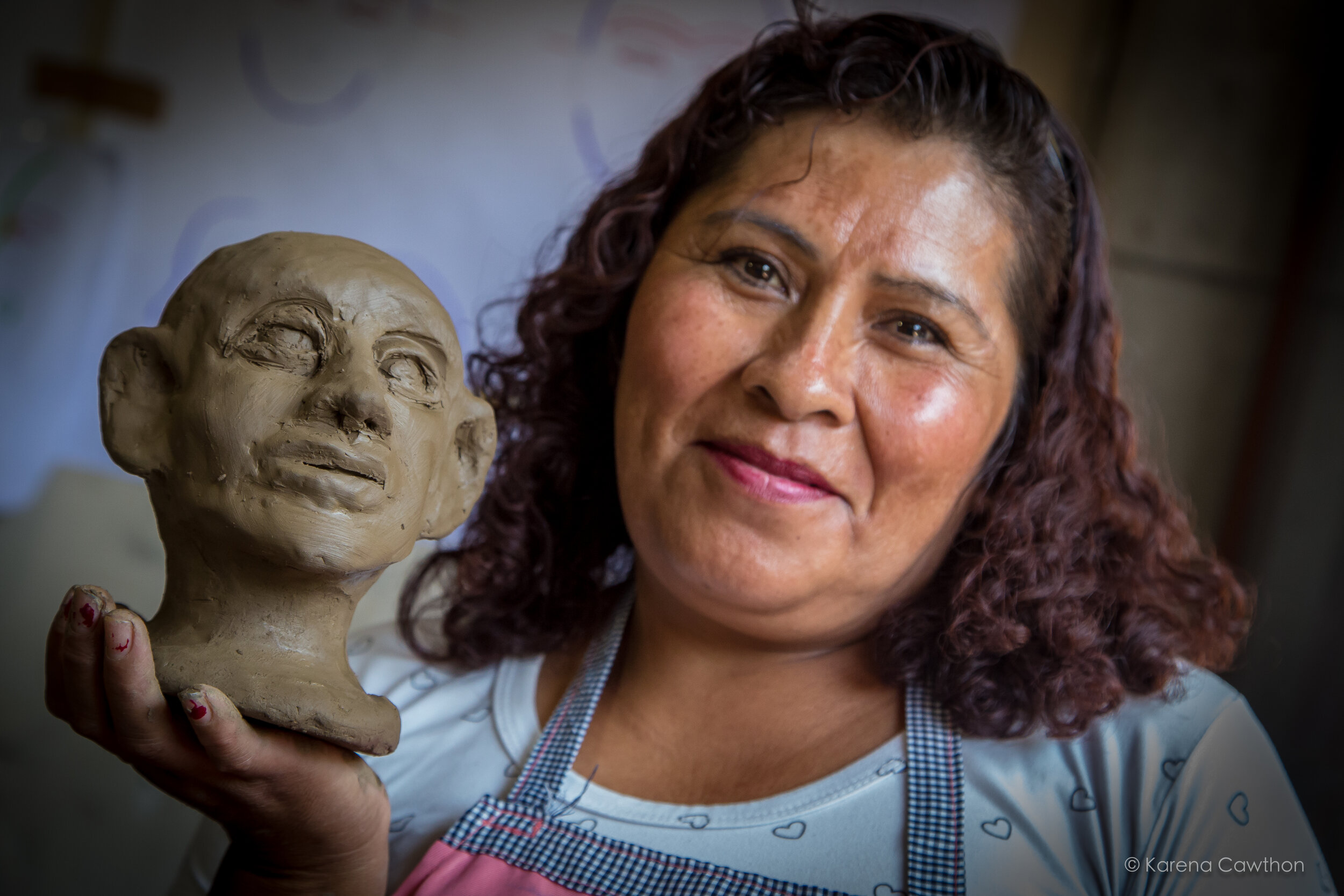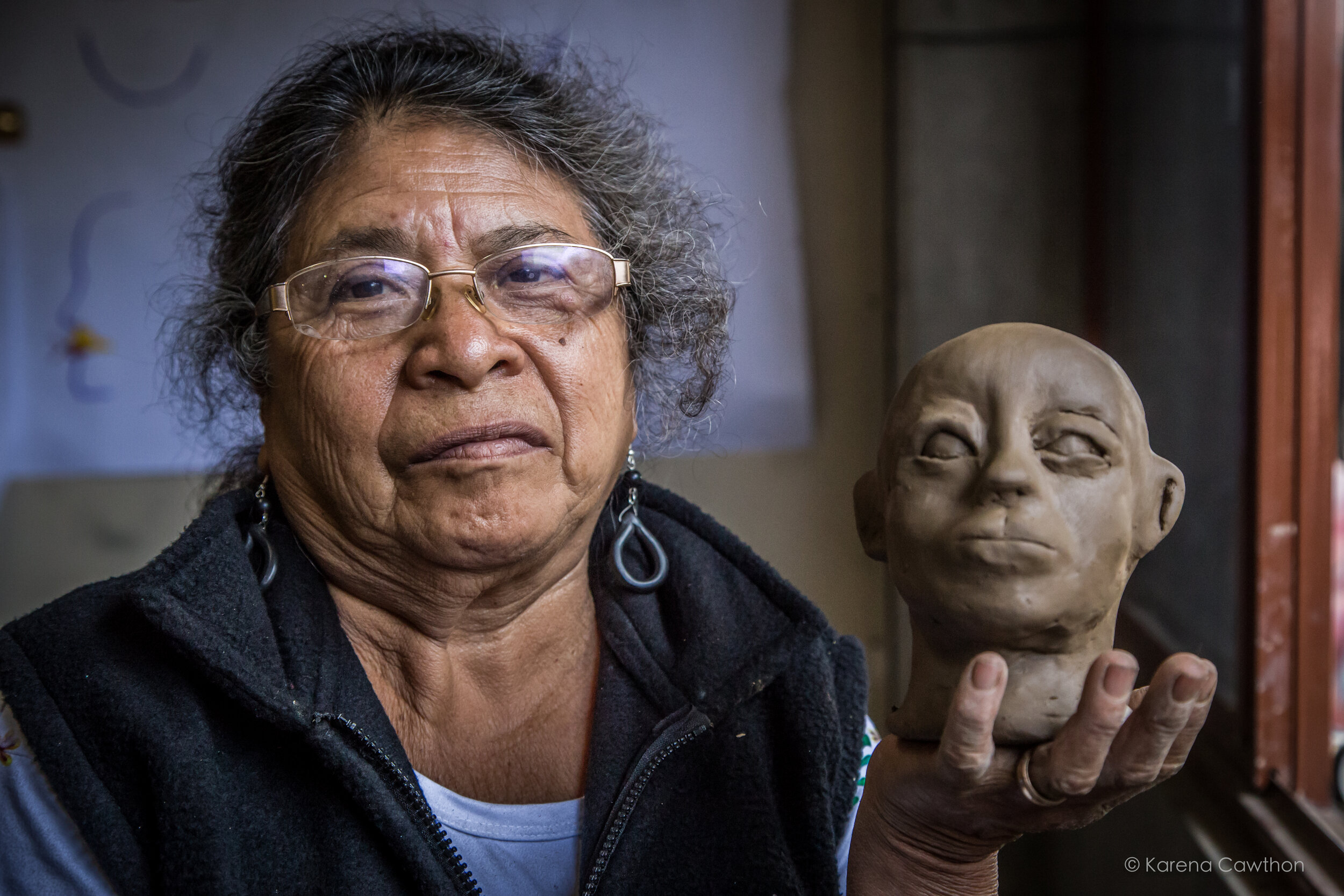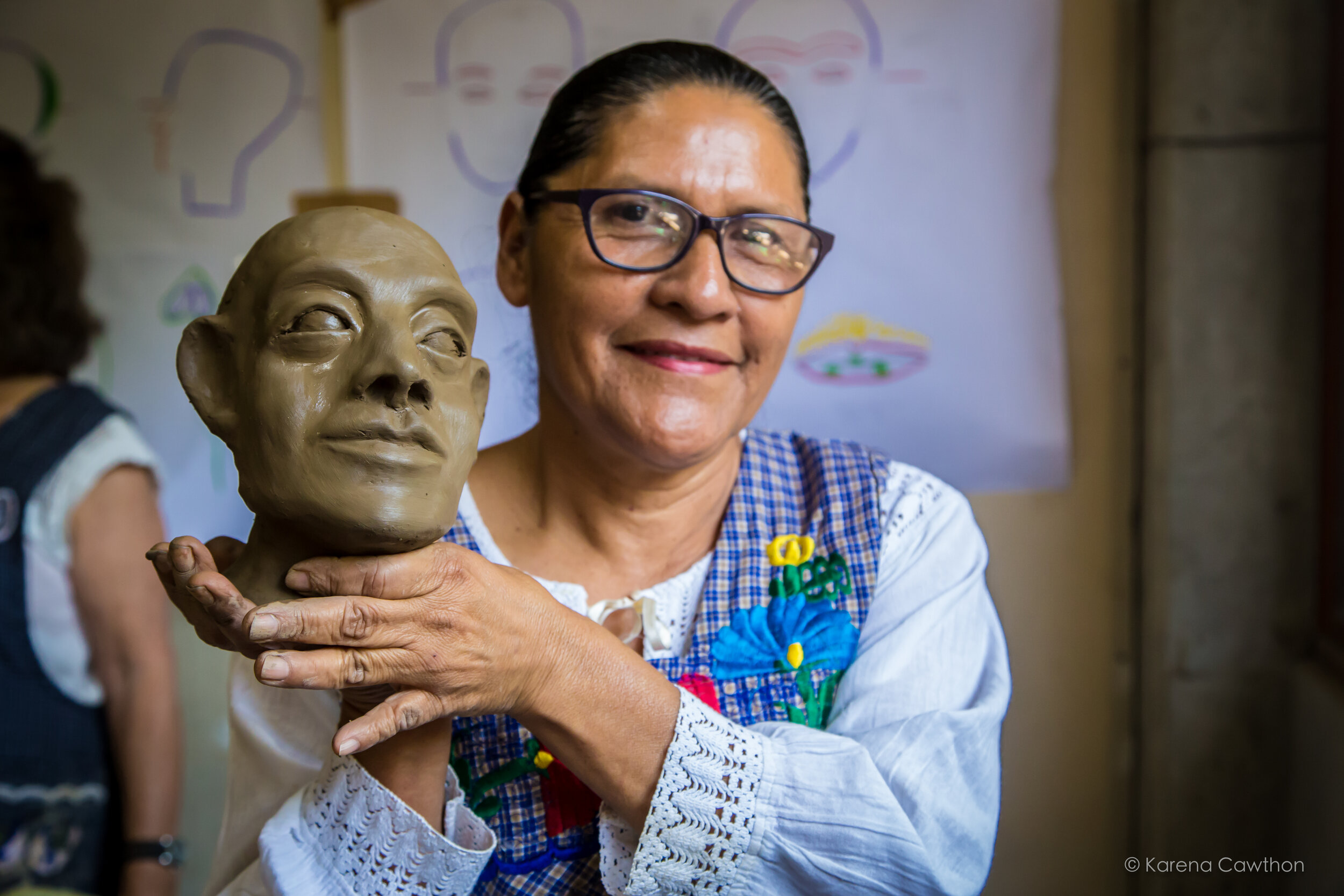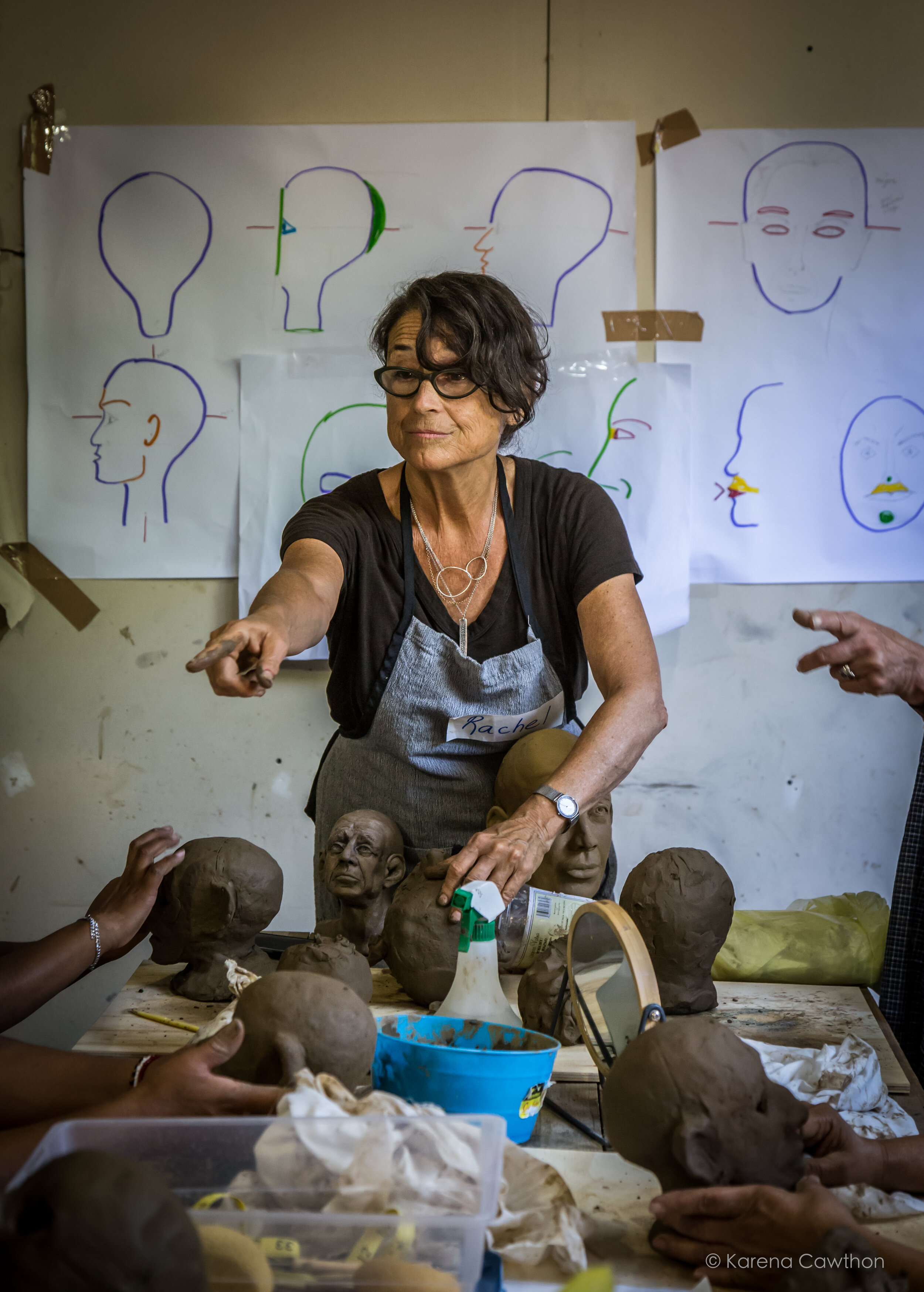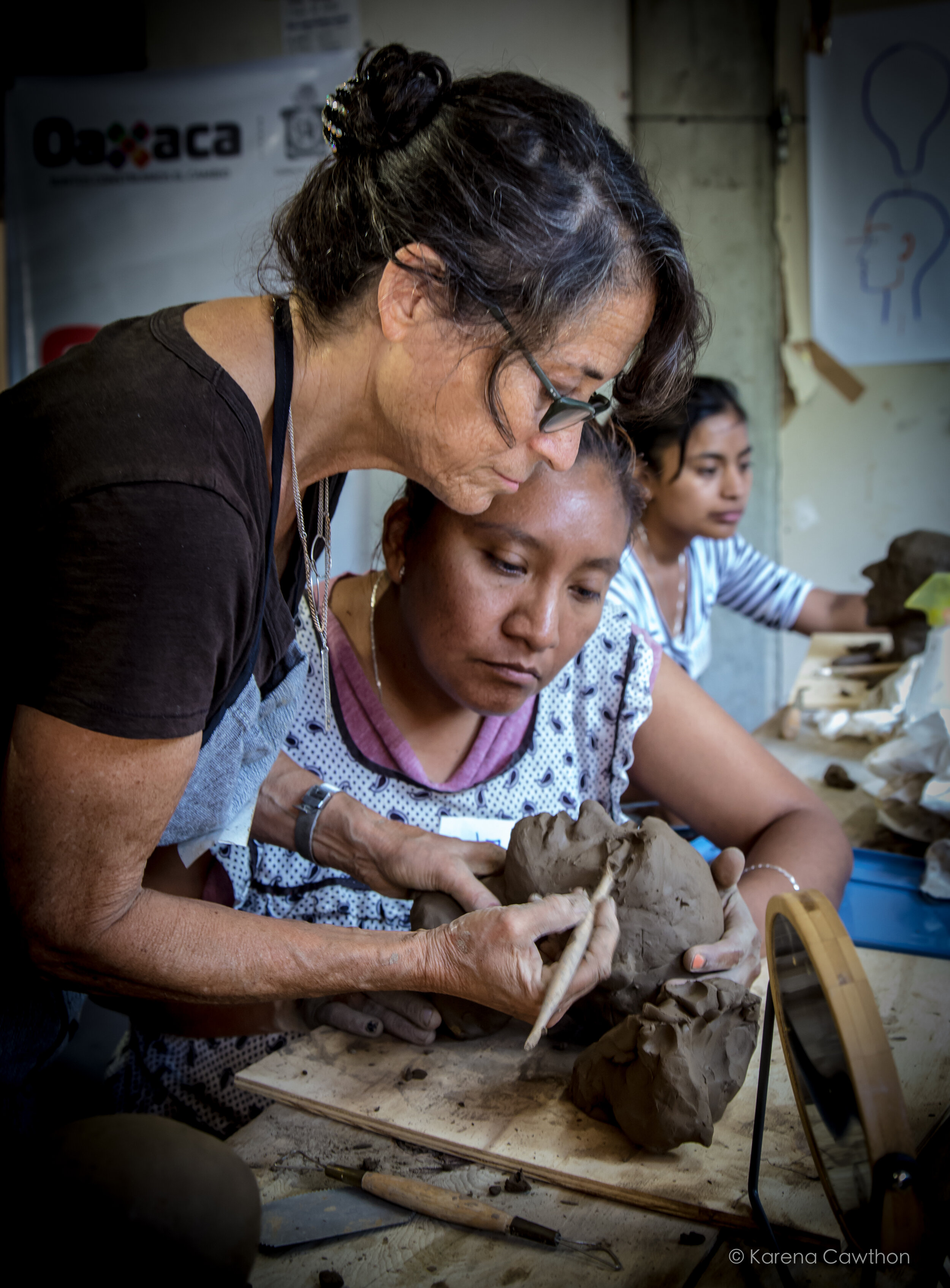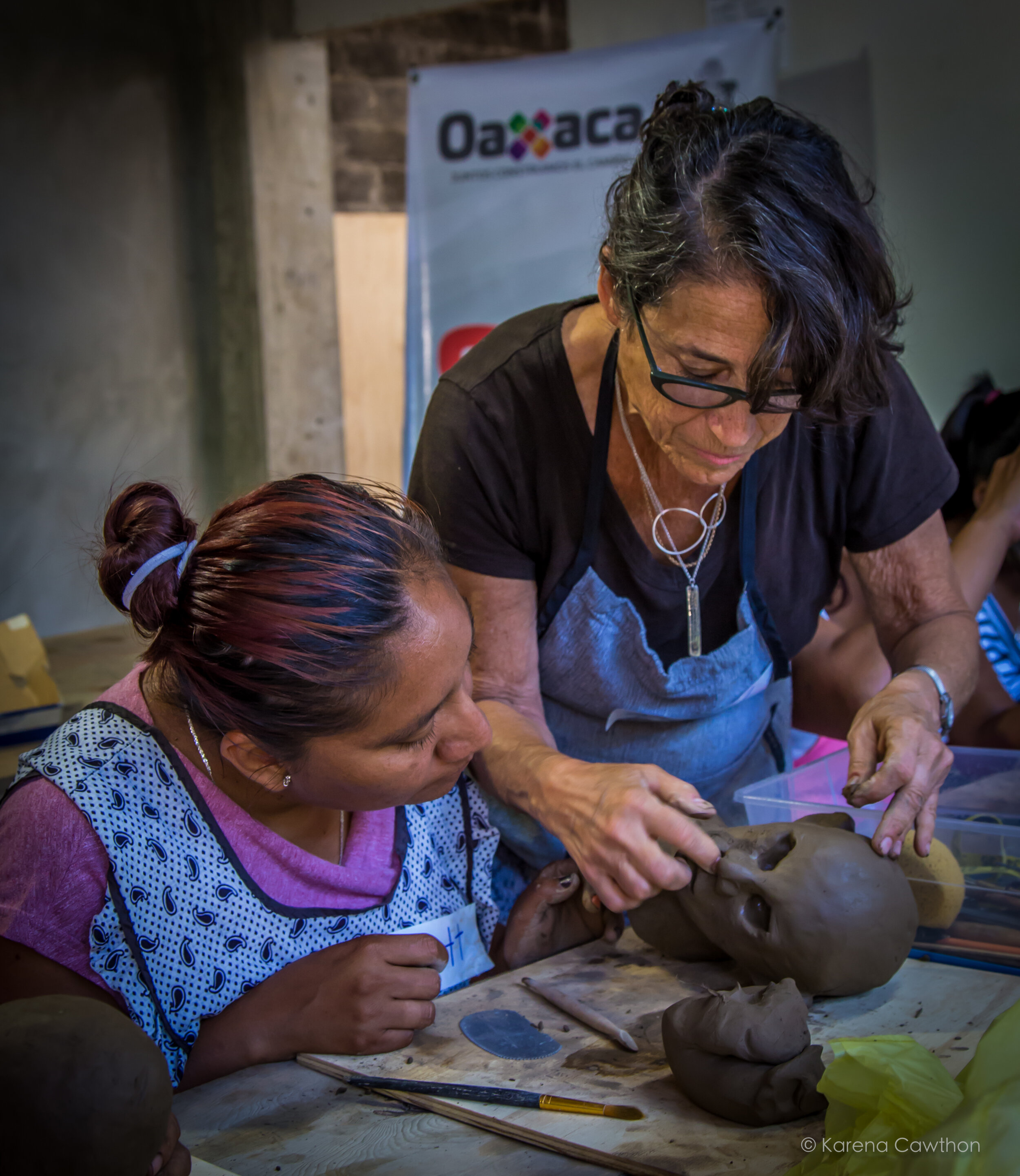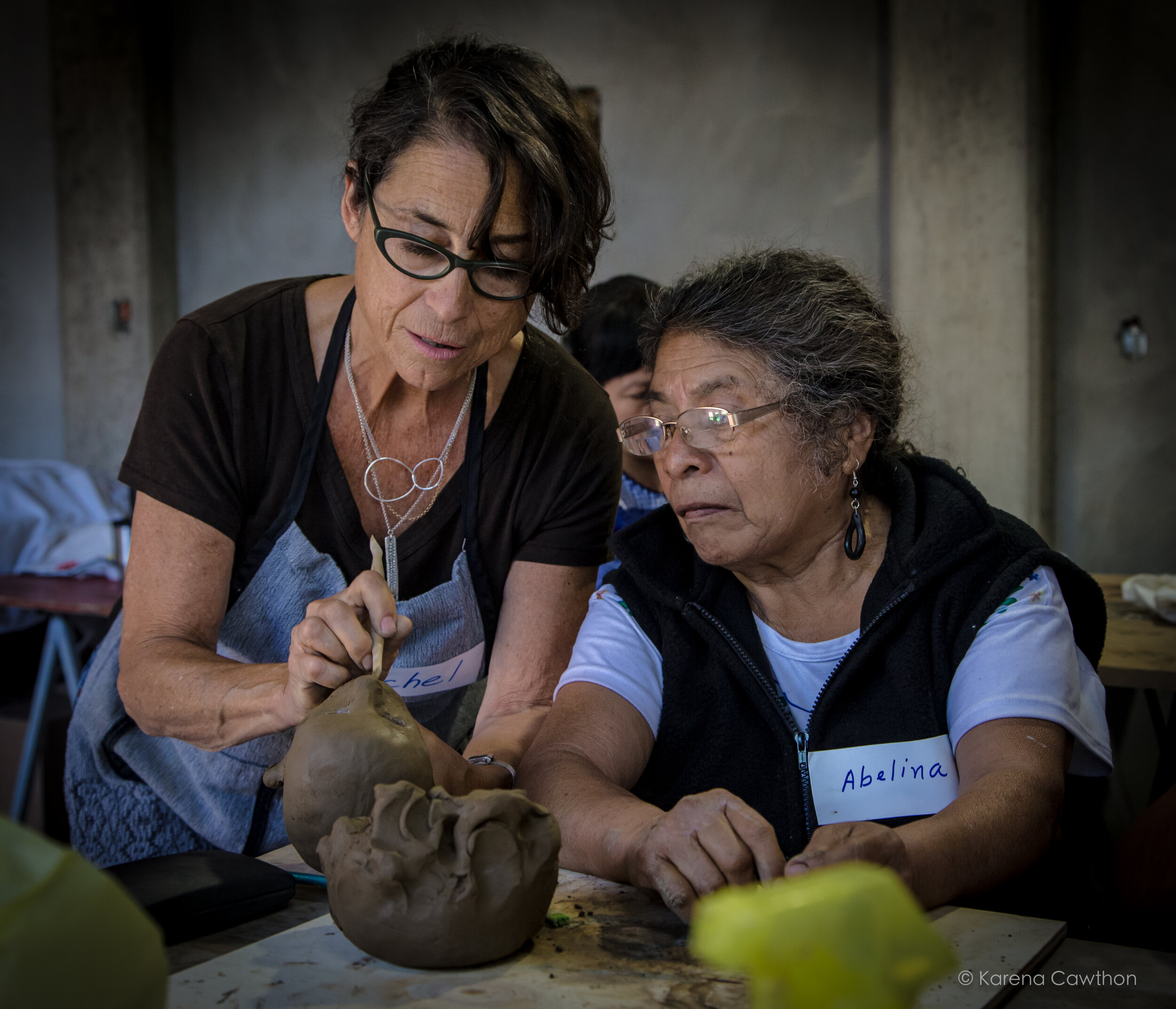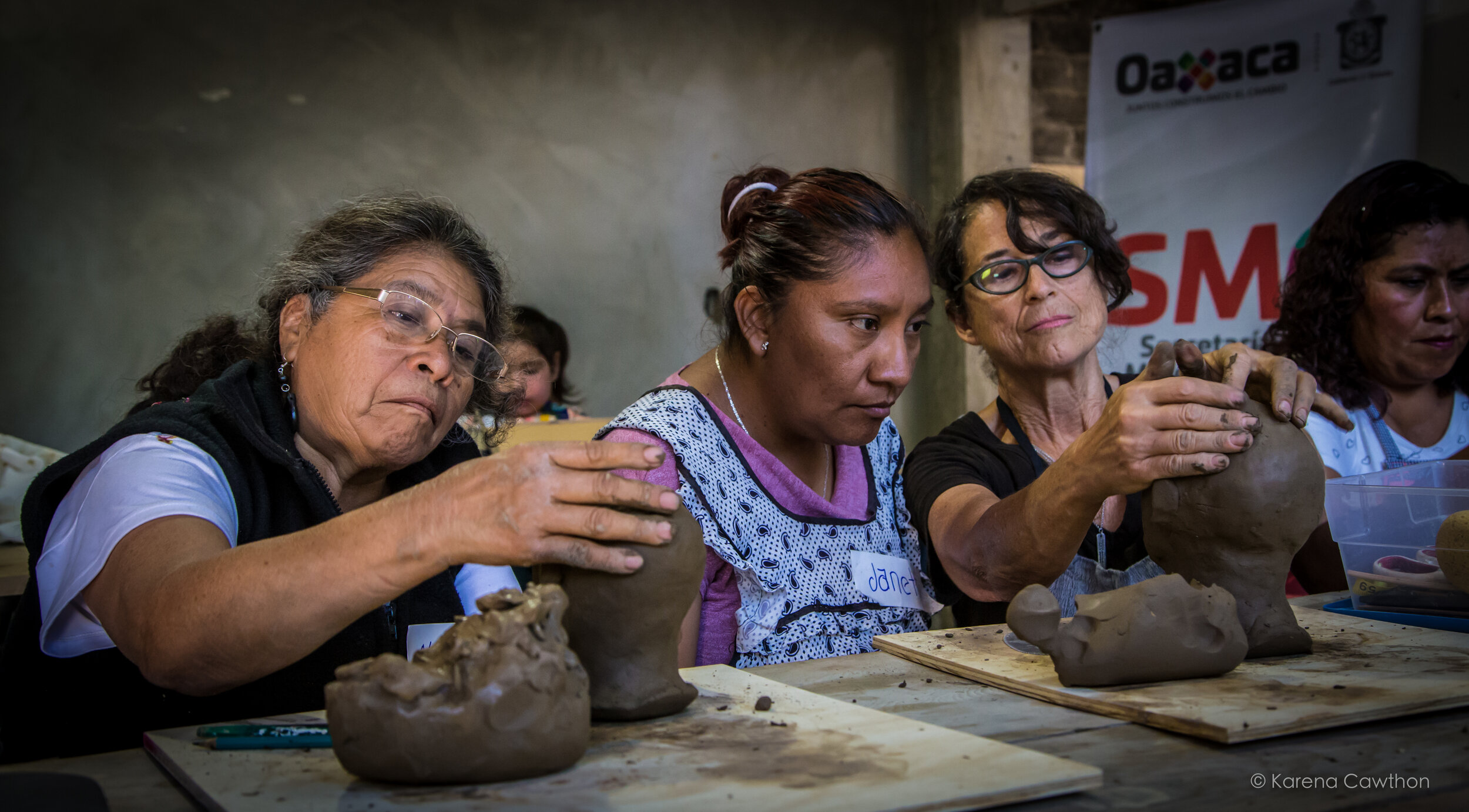PHOTOGRAPHY BY KARENA CAWTHON
San Bartolo de Coyotepec is a quiet town about half an hour outside of Oaxaca, Mexico, best known for its iconic black pottery, not for its domestic abuse. Yet here I am, in the tiny backseat of a Fiat 500 headed for San Bartolo, where I am about to launch a pilot program for the Oaxacan Ministry of Women (La Secretaria de las Mujeres de Oaxaca). Art therapy for victims of domestic abuse.
No, I’m not a social worker or a women’s rights activist. I’m just an artist spending the winter in Oaxaca. I’m the kind of person who supports a cause by writing a check, not by getting into a car and trundling off into the countryside of a foreign country to literally put my hands on the line.
But I had agreed to teach a sculpture workshop to women in this town, women who were the victims of domestic abuse. If not themselves abused and injured, some are mourning the murder of a sister or mother, and taking care of children now motherless. Femicide is a deadly threat posed to Mexican women, especially those in remote villages ruled by a culture of machismo. But the Minister of Women, Ana Isabel Vasquez Colmenares Guzman, wants to change all that. And this pilot program is one small step in that direction.
My journey to San Bartolo began when the owner and director of the Larimar Gallery in Oaxaca, Dulce Maria Mendez Garcia, asked if I could contribute some sculpture to a show she had planned for March, Women’s Month in Oaxaca. This show was for women artists exhibiting primarily women-centered art, and it was named for Leona Vicario, a national heroine who is known as the Mother of the Mexican Revolution. Dulce Maria asked me to make a sculpture of Leona Vicario for the show. I did, and I also contributed a few other pieces.
For the show at Larimar Gallery in Oaxaca, I made a sculpture of Leona Vicario, a national heroine who is known as the Mother of the Mexican Revolution.
She then asked if I’d be willing to teach a sculpture workshop to women in San Bartolo. Because of my wobbly Spanish, I didn’t understand exactlywho I would be teaching. I figured it was the artisan women who were making the black clay pottery. They wanted to learn figurative sculpture, I thought, how wonderful! I signed on to teach three workshops, on three successive Saturdays in March. It was only later than I realized that my students were not artisans, they were victims of domestic abuse.
At the opening of the gallery show, there was a large crowd including the Minister of Women and some of her colleagues. Many of the artists showing work there came as well, many wearing traditional Mexican clothing, in my experience this was an unusual sight for an art gallery in Oaxaca. But more unusual was the opening itself, which included passionate speeches about the condition of women, and certificates handed out to all the artists. When I walked to the dais and accepted my certificate, I was also praised and applauded for my upcoming workshop for abused women. I sat back down, kind of stunned. What had I gotten into?
“But I’m not an art therapist,” I said later to the gallery owner. No problem, she said. “But I’m not an art therapist,” I said to the Minister of Women. No problem, she said, the women just need to feel safe and do something with their hands. It will be therapeutic.
This woman had experience working with clay, and it showed in her work.
The next week, we all drove to San Bartolo to meet the president of the municipal authority governing the town to ask his permission to teach this class. San Bartolo is a municipal seat comprising a number of small villages, and like many Mexican towns, its governance is very hands-on, personal, and local. He made an appearance at the start of the first workshop, as did the mayor of San Bartolo and many others in positions of authority or who worked with women’s issues locally.
This student made beautiful earrings and other objects out of clay. This was her first foray into figurative sculpture.
This was a fraught time for women in Mexico. International Woman’s Day was coming up and protestors had a lot to protest about. There had been particularly shocking and heinous crimes against women during that year, and feminist activists had had enough of the machismo culture that was allowing the abuse and even murder of women, often by their own family members. Women took to the street in Oaxaca on March 8, marking up storefronts with their slogans and demands. On March 9, there was a 24-hour woman’s strike.
In that environment, the fervor of the Ministry for Women was understandable, as was their desire to do something immediate and positive for some of the victims of violence against women. So, armed with trepidation and boxes full of sculpture tools, and, most importantly, with my dear friend Marisa Bevington by my side to translate for me, I took off for my workshop in San Bartolo.
Me with a pile of heads. Leaning against me, two that I brought for illustration. The black clay the students are using comes from this area in Mexico.
We held the class in the clay studio of one of the family-owned black pottery businesses in the town. Here they produce the beautiful, nationally renowned black pottery so valued by the growing tourist market. This studio has supplied all the students with clay and will fire their finished pieces in a wood-fire pit kiln at the conclusion of the workshop. The Ministry of Women took care of all the expenses.
We grouped around a table and I introduced myself (terribly) in Spanish – I had rehearsed this intro the entire previous week and yet it came out so garbled and mispronounced I am surprised they could keep a straight face. But they did. They were respectful to their “profesora.”
Once I stood up and started teaching, shaping clay heads, illustrating how to make eyes and noses, it didn’t matter how bad my Spanish was or if the women were suffering from emotional distress – we all got into making art and having fun.
Marisa Bevington, native Spanish speaker from Argentina, translated and was a major player in helping the workshop succeed.
When my waving hands and demonstrations and diagrams weren’t enough to communicate a thought or technique, Marisa was there to speak for me. She was an invaluable addition to the workshop, not only for her translation skills, but for her warmth and humor. Marisa wanted to not only translate, she wanted to participate, to make a sculpture for herself. An accomplished painter, Marisa has little experience with clay and sculpture. So the clay head she produced was no better than most of the other students’ work. And in point of fact, it was worse than some! The women adored this. I teased Marisa, and they laughed and laughed. It made them feel good that the assistant “maestra” was having the same problems they were in sculpting a head.
But the laughter doesn’t eliminate the pain. Marisa overheard one woman say, “The fact that we smile and have a happy appearance doesn’t mean that we are not suffering inside. We need to have a happy exterior for our children and family because we are a reflection for them.”
Another woman said that she loves this work with sculpture because she forgets everything else while working on her clay.
I think this is what the Minister of Women was hoping for. To give these women a few hours of respite every week. Hours when they could just experience the tactile pleasure of hands in clay and a few moments like these of joyful creation.
Workshop students and at far end, on either side of me, Ira Velasco from La Secretaria de las Mujeres de Oaxaca and Dulce Maria Mendez Garcia, owner and director of the Larimar Gallery in Oaxaca. Next to Dulce Maria is Marisa Bevington, artist and translator.

